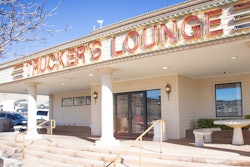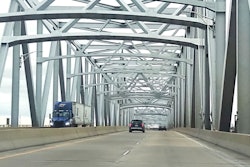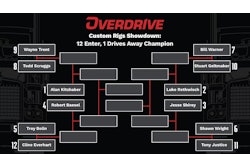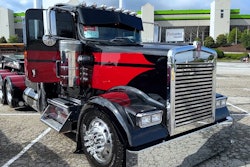The author of this two-part story, Matthew Patrick, works in sales and operations with a mid-size fleet and brokerage headquartered in the Northeast. Since identifying double brokering instances with his own businesses, he’s been focused closely on shining a light on its negative impacts within trucking. Read more about him via this link.
What double brokering truly costs trucking is unknown, but estimates put the number in the 10s of millions of dollars. But such estimates likely only attempt to count the frauds that are actually identified for what they are. Meanwhile, hundreds -- maybe even thousands -- of loads are double brokered daily with neither the original broker nor final carrier even realizing it.
Let’s define the standard brokered freight transaction: A shipper hires a broker to find a truck to transport the shipper's load. The broker hires a carrier to service the load, which that carrier then delivers.
In this particular double brokering scenario, instead of the hired carrier delivering the load, they instead give the load to a second broker, and that broker hires a trucking company to deliver the load.
*Normal: Shipper > Broker > Carrier -- Load delivers *Double brokered: Shipper > Broker > Carrier > Broker > Carrier -- Load delivers
Neither the shipper nor the first broker -- nor the final carrier -- in the chain has any knowledge of the double brokering. Thus there is no chain of custody on the shipper's freight, and the rate the final carrier gets paid now has two brokers’ cuts taken out of it.

To stay under the radar these days, double brokers in most cases we’ve seen are in fact paying the actual carrier who delivered the load, albeit at a reduced amount. Obviously, this sinks rates for real carriers involved in these schemes, reducing profits. By paying the actual carriers, double brokers/connected carrier entities (the italicized portions of the "double brokered" chain illustrated above) avoid detection, establish a credit history, and build a reputation.
Often enough, though, caught one too many times by legitimate brokers or carriers, they run out of road -- their reputation takes a hit as word spreads via social networks and basic word of mouth, and among monitoring services. That is when some implement the “take the money and run” phase of a double broker's evolution. They take the paperwork received from the final carrier and give that to the first “carrier” -- clearly in cahoots with the second broker, maybe even the same person in some cases. That “carrier,” used originally to book the load with the legitimate broker, submits the real carrier’s paperwork as proof of delivery to request quick pay.
At this point, they’ll take the money and run.
Given typical terms specify 30 days for payment, the final carrier may be none the wiser for a month or more, and the double broker can repeat the process as many times as he/she can before it catches up to them, with thousands in pure profit generated. When legitimate carriers start looking for payment, it's nowhere to be found.
Yet double brokering is an addressable problem for trucking.
[Related: A 'hit it and move on' broker scam, and more loopholes]
Low-hanging regulatory fruit: Carriers/brokers registered in ‘virtual offices’
Most of the registered carriers we’ve seen who are set up to execute these schemes register a “virtual office” address as their physical address with the Federal Motor Carrier Safety Administration. If you’ve never heard that term, virtual offices are glorified P.O. Box addresses. They provide the ability to receive mail at a location with a street address and offer office space available to rent, often on an hourly basis.
Carriers registering at these locations are in violation of the FMCSA’s principal place of business regulations. No company personnel work at these locations, no vehicles are kept or maintained on-site, and no legally required records can be stored here, as there is no permanent office space.
This may be the lowest hanging fruit from a regulatory perspective. If the FMCSA dedicated a team of personnel to request an audit of these entities, many would be put out of service, given they are not an actual trucking operation.
The FMCSA does not have principal place of business requirements for freight brokers at present. That means when a double broker switches to the “take the money and run” phase of the operation, there is little recourse available to try and collect payment outside of emails and phone numbers (often swiftly disabled) and bond claims (often swiftly exhausting bond limits). I feel it’s irresponsible for the FMCSA to allow freight brokers to register using a virtual office as their principal place of business. These virtual offices can be had for as little as $25-$50 a month.
[Related: 'WTFFMCSA': Carrier mocking the agency through its own registration system?]
Yet register they do, as do bad-actor carriers connected to them. When one of these bad-actor carriers is able to register with the FMCSA and appear legitimate on paper, the next hurdle to jump through is to get set up with legitimate brokers, fairly easily. Once they are set up, it just takes a few clicks for a very busy broker rep to send a load over to the nefarious carrier. When the load gets delivered on time, the broker sees the bad-actor carrier as reputable and may continue to give them loads.
Some such brokers get flagged in Reddit/LinkedIn or other social networks as “feeding double brokers” and “keeping them in business.” Outside of this kind of reputational damage, there is no real penalty for a broker knowingly or unknowingly tendering loads to a carrier who has no intent to service the freight. We’ve seen a broker tender six loads simultaneously to a carrier MC# with just a single vehicle insured and listed in that carrier’s Safer profile. All six of those loads were double brokered. We learned this after connecting with the legitimate broker on the load. We had accepted (knowingly) a load from the double broker, as we had a truck in the area who could service the load and thought it would be a good opportunity to catch them, connect with the real broker, and get set up directly with them.
After we picked up the load and connected with the real, original broker, we were asked not to say anything to the double broker who’d given us the load. The real broker had six active loads tendered to the single-truck carrier MC# connected to the double broker and likely did not want those loads disturbed. It took days to get this resolved with the real broker, as they wanted their other freight delivered. It’s still unclear if the real broker connected with their shippers/receivers to try to ascertain who the legitimate carriers were on these loads to pay them directly, or if they simply paid the "carrier" who booked the load and hoped the money would flow to the legitimate carriers.
In such schemes, as noted, whether the original broker knows what they are getting themselves into is up for debate, but it is clear legitimate brokers who get hoodwinked into these schemes don’t have satisfactory carrier-vetting processes in place. Until there are incentives for brokers to better vet their carriers, you will continue to see operational malpractice of this type.
[Related: How do you know you're working with a double broker? Increasingly it's hard to tell]
In other cases where a legitimate carrier determines they are hauling a double brokered load, when they get in touch with the original broker after realizing what’s going on, way too often the carrier isn’t rewarded for bringing this to the attention of the real broker. Often enough, the original broker will simply set up the legitimate carrier in their system, then try to pay that carrier the same reduced rate the double broker was offering them, rather than their original rate offered to the bad actors.
For instance, consider the following hypothetical, where the original broker earns himself an extra $150 by taking advantage of a legitimate carrier’s recognition of the double brokering involved.
Shipper > Broker -- $2,000 rate agreed to
Broker > Double brokering, bad actor carrier -- $1,750 agreed to and not paid
Double broker > Carrier -- $1,600 agreed to and ultimately paid by the original broker
Without the original broker’s help, carriers hoping to be a part of the solution to the problem run into obstacles. Larger brokers are typically unwilling to share the original rate confirmation they tendered to the bad-actor carrier. This is a crucial piece of evidence to create a link between the carrier MC# out there obtaining loads and the broker MC# then double brokering the freight. Load boards’ prohibitions on double brokering on their platforms are generally only enforceable with shared copies of the original rate confirmation. Load boards often fail to act to suspend an account unless they have this rate confirmation from the original broker.
As noted, too many brokers are not willing to share these with the carrier -- they simply put the bad-actor carrier MC# on an internal Do Not Use list, creating a safe harbor, another layer of protection, for bad actors. Though reliable figures for the total number of registered brokers are hard to come by, in five years beginning with 2015 more than 20,000 broker entities newly established authority (about half had their authority revoked over the same period). That doesn’t count the many other thousands of licensed freight brokers long in operation. Suffice it to say, a carrier entity put on a Do Not Use list by one has plenty of other options to choose from. They find them on the boards, and load boards are the lifeblood of double-brokering operations.
[Related: FMCSA, DOT getting serious about double brokering?]
Bad-actor carrier MC#s can view thousands of loads daily to try and obtain them with no intent to move any of them. Similarly, load boards are the venue where the bad-actor broker entity reposts these loads (typically, but not always, masking the actual origin or destination info) to be double brokered.
Load boards are in a precarious situation in that every customer of theirs, whether good or bad, is a paying customer. Every account that violates a board’s common no-double-brokering provisions and gets de-platformed means lost revenue. Patience has worn thin for some among boards’ legitimate customer base. Some boards have only allowed original brokers of a double-brokered load to file a complaint about the scheme. Others allow both carriers and brokers to lodge complaints, yet little meaningful dialogue occurs in the event of a decision to allow a bad-actor carrier/broker to remain on the platform. We have seen multiple cases submitted against double brokers (all with relevant evidence) where no action was taken. Months later, some of these same previously reported brokers are showing up on collection agencies’ emails for nonpayment.
Some freight marketplaces have a different set of incentives to wrestle with: growth. As divisions within publicly traded companies, these enterprises are encouraged to show a growing base of carriers in their network. How many of these carriers, however, are strictly on-platform with the intent to obtain freight to be double-brokered? If you are a carrier who was double brokered by one of these giants, getting in touch with the appropriate personnel to communicate this can be nearly impossible. Yet again, another safe harbor for bad actors.
Read next: How carriers and brokers can work to combat double brokering: Potential red flags, more











